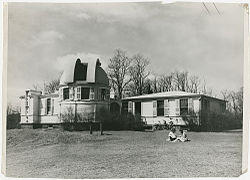 The Williston Observatory, circa 1945-1955 | |||
| Organization | Mount Holyoke College | ||
|---|---|---|---|
| Location | Jewett Lane South Hadley, Massachusetts, United States | ||
| Coordinates | 42°16′N72°16′W / 42.26°N 72.26°W | ||
| Altitude | 231 feet | ||
| Weather | South Hadley Weather | ||
| Established | 1881 [1] | ||
| Website | |||
| Telescopes | |||
| |||
The John Payson Williston Observatory is an astronomical observatory located at the highest point on the Mount Holyoke College campus. Constructed in 1881, the observatory is a modest building with a rare 8" Alvan Clark refractor telescope created just before his death in 1887. It is maintained and operated by the Mount Holyoke College Astronomy Department.

